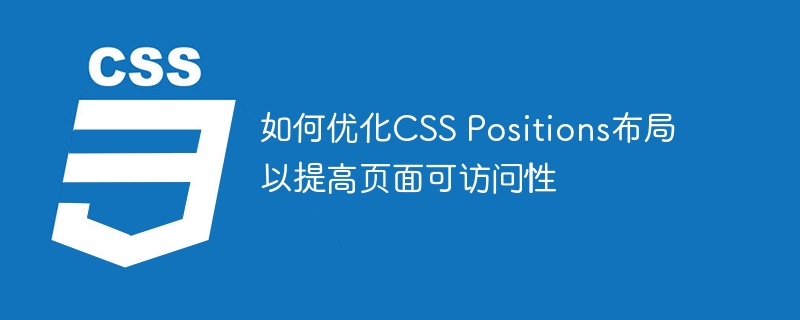

How to optimize CSS Positions layout to improve page accessibility
As front-end developers, we often need to use CSS to implement page layout. Among them, CSS Positions layout is a commonly used technology, which implements layout by positioning elements. However, if CSS Positions layout is applied improperly, it can lead to reduced accessibility of the page. In this article, we’ll explore how to optimize CSS Positions layout to improve page accessibility, and give specific code examples.
1. Interactive effects that do not rely on scripts
When using CSS Positions layout, we often use some interactive effects to enhance the visual appeal of the page. However, these interactive effects usually rely on JavaScript to achieve. In some cases, users may have disabled JavaScript or are using auxiliary tools that do not support JavaScript. Therefore, we should consider whether the page can be accessed and used normally without scripts.
The following is a specific example, using CSS Positions to achieve the effect of a pop-up window:
HTML code:
<div class="container">
<button class="button">点击弹窗</button>
<div class="popup">
<h2>弹出窗口标题</h2>
<p>弹出窗口内容</p>
<button class="close">关闭</button>
</div>
</div>CSS code:
.container {
position: relative;
}
.popup {
position: absolute;
top: 50%;
left: 50%;
transform: translate(-50%, -50%);
display: none;
/* 其他样式... */
}
.container:hover .popup {
display: block;
}
.close {
position: absolute;
top: 0;
right: 0;
/* 其他样式... */
}In this example, the popup appears when hovering over the button. However, if the user has disabled JavaScript, the popup will not display properly. In order to solve this problem, we can use other ways to achieve similar effects, such as using CSS:target pseudo-class.
Modified HTML code:
<div class="container">
<a href="#popup" class="button">点击弹窗</a>
<div id="popup" class="popup">
<h2>弹出窗口标题</h2>
<p>弹出窗口内容</p>
<a href="#close" class="close">关闭</a>
</div>
</div>Modified CSS code:
.container {
position: relative;
}
.popup {
position: fixed;
top: 50%;
left: 50%;
transform: translate(-50%, -50%);
display: none;
/* 其他样式... */
}
#popup:target {
display: block;
}
.close {
position: absolute;
top: 0;
right: 0;
/* 其他样式... */
}By using the :target pseudo-class, we can add a #popup anchor to the link Click to open the pop-up window, and add the #close anchor point in the pop-up window to close the pop-up window. In this way, even if the user has disabled JavaScript, similar interactive effects can be achieved through the native anchor function.
2. Follow the mainstream reading order
When optimizing CSS Positions layout, we should follow the mainstream reading order to ensure the accessibility of the page in readers or screen readers. Generally speaking, the mainstream reading order is from top to bottom and from left to right. Therefore, when implementing CSS Positions layout, the layout should be carried out in this order.
The following is a specific example showing how to use CSS Positions layout to implement a page navigation menu:
HTML code:
<nav class="menu">
<ul>
<li><a href="#">首页</a></li>
<li><a href="#">关于我们</a></li>
<li><a href="#">产品</a></li>
<li><a href="#">联系我们</a></li>
</ul>
</nav>CSS code:
.menu {
position: fixed;
top: 0;
left: 0;
/* 其他样式... */
}
.menu ul {
list-style: none;
/* 其他样式... */
}
.menu ul li {
display: inline-block;
/* 其他样式... */
}
.menu ul li a {
display: block;
/* 其他样式... */
}In this example, the navigation menu is implemented by positioning the menu to the upper left corner of the page. However, if we place the menu elsewhere on the page, such as the upper right corner of the page, the order of page reading will become confusing. In order to solve this problem, we can use CSS flexbox layout to achieve center alignment of the navigation menu.
Modified CSS code:
.menu {
display: flex;
justify-content: flex-end;
/* 其他样式... */
}By using display:flex and justify-content:flex-end, we can center-align the navigation menu and maintain the mainstream reading order.
Summary:
By properly applying CSS Positions layout, we can improve the accessibility of the page. First, we should avoid relying on scripts for interactive effects and consider whether the page can be accessed and used normally without scripts. Secondly, we should follow the mainstream reading order to ensure the accessibility of the page in readers or screen readers. Through the above optimization measures, we can provide users with a better user experience.
The above is the detailed content of How to optimize CSS Positions layout to improve page accessibility. For more information, please follow other related articles on the PHP Chinese website!




